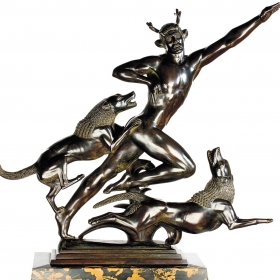After Paul Manship returned to New York from travels in Greece and Italy in 1912, he exhibited 96 cast bronzes made on his travels—and sold every single one. He was considered one of America’s preeminent sculptors in the period between the two world wars.

Actaeon, 1924, Paul Manship, Bronze on marble period base, 25 ⅝ in. x 31 ¾ in. by 7 ⅞ in., Gift of Mary White ’79
The chilling story of Actaeon’s transformation into a stag can be found in Ovid’s Metamorphoses. Walking in the woods, the huntsman Actaeon stumbles upon the goddess Diana bathing in a grotto. As punishment for seeing her naked, Diana causes Actaeon to gradually turn into a stag. At first, he doesn’t realize what is happening, and when he does, it’s too late: His own dogs attack him and tear him to pieces.
This dramatic bronze sculpture, a campaign gift to the Davis Museum from Mary White ’79, was created by American sculptor Paul Manship (1885–1966) and its subject reflected his ongoing fascination with Greek and Roman mythology. A Prix de Rome scholarship in 1909 had enabled him to study and travel throughout Italy and Greece, where he fell in love with classical Roman and Greek art. After his return to New York in 1912, Manship exhibited 96 cast bronzes made on his travels—and sold every single one. He was considered one of America’s preeminent sculptors in the period between the two world wars.
Manship’s art, with its emphasis on sleek shapes and clean lines, fit neatly under the label of art deco, a style encompassing everything from fashion to modes of transportation. Architects and titans of industry commissioned the artist to create sculptures for their buildings that reflected the classical virtues of proportion, symmetry, and balance. Manship’s most famous commission was the huge, gilded sculpture of Prometheus for the fountain at Rockefeller Center plaza in New York, which he made in 1933.
Over the decades, Manship’s sculptures have gone in and out of fashion; one critic in a 1991 review of an exhibition on Manship called his work facile and repetitive. While Manship may not have broken new ground in the field of American sculpture, his work does lean toward modernism. His figures, particularly Actaeon, seem ready to fly off the pedestal onto which they were installed.
Manship’s own statements indicate that he would not have cared a fig about the critic’s opinion: “… What matters is the spirit which the artist puts into his creation—the vitality, the rhythm, the emotional effect.”

